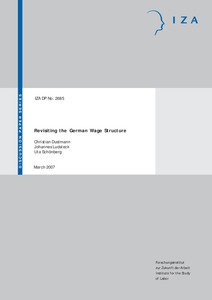Revisiting the German wage structure
"This paper challenges the view that the wage structure in West-Germany has remained stable throughout the 80s and 90s. Based on a 2 % sample of social security records, we show that wage inequality has increased in the 1980s, but only at the top of the distribution. In the early 1990s, wage in...
| Main Authors: | , , |
|---|---|
| Institution: | ETUI-European Trade Union Institute |
| Format: | TEXT |
| Language: | English |
| Published: |
Bonn
2007
IZA |
| Subjects: | |
| Online Access: | https://www.labourline.org/KENTIKA-19125829124919430019-Revisiting-the-German-wage-str.htm |
| _version_ | 1771659894489874435 |
|---|---|
| author | Dustmann, Christian Ludsteck, Johannes Schönberg, Uta |
| author_facet | Dustmann, Christian Ludsteck, Johannes Schönberg, Uta |
| collection | Library items |
| description | "This paper challenges the view that the wage structure in West-Germany has remained stable throughout the 80s and 90s. Based on a 2 % sample of social security records, we show that wage inequality has increased in the 1980s, but only at the top of the distribution. In the early 1990s, wage inequality started to rise also at the bottom of the distribution. Hence, while the US and Germany experienced similar changes at the top of the distribution throughout the 80s and 90s, the patterns at the bottom of the distribution are reversed. We show that changes in the education and age structure can explain a substantial part of the increase in inequality, in particular at the top of the distribution. We further argue that selection into unemployment cannot account for the stable wage structure at the bottom in the 80s. In contrast, about one third of the increase in lower tail inequality in the 90s can be related to de-unionization. Finally, fluctuations in relative supply play an important role in explaining trends in the skill premium. These findings are consistent with the view that technological change is responsible for the widening of the wage distribution at the top. The widening of the wage distribution at the bottom, however, may be better explained by episodic events, such as changes in labour market institutions and supply shocks. " |
| format | TEXT |
| geographic | Germany |
| id | 19125829124919430019_a717537c04364eb9bd97e6e495e2e4d9 |
| institution | ETUI-European Trade Union Institute |
| is_hierarchy_id | 19125829124919430019_a717537c04364eb9bd97e6e495e2e4d9 |
| is_hierarchy_title | Revisiting the German wage structure |
| language | English |
| physical | 45 p. Digital |
| publishDate | 2007 |
| publisher | Bonn IZA |
| spellingShingle | Dustmann, Christian Ludsteck, Johannes Schönberg, Uta equal pay statistics wage structure wages Revisiting the German wage structure |
| thumbnail | https://www.labourline.org/Image_prev.jpg?Archive=100461392864 |
| title | Revisiting the German wage structure |
| topic | equal pay statistics wage structure wages |
| url | https://www.labourline.org/KENTIKA-19125829124919430019-Revisiting-the-German-wage-str.htm |

